 Music
Music  Music
Music  History
History 10 Less Than Jolly Events That Occurred on December 25
 Weird Stuff
Weird Stuff 10 Funny Ways That Researchers Overthink Christmas
 Politics
Politics 10 Political Scandals That Sent Crowds Into the Streets
 Weird Stuff
Weird Stuff Ten Bizarre Facts About The Doge Meme
 Our World
Our World 10 Ways Your Christmas Tree Is More Lit Than You Think
 Movies and TV
Movies and TV The 10 Coolest Stars to Set Sail on The Love Boat
 History
History 10 Things You Didn’t Know About the American National Anthem
 Technology
Technology Top 10 Everyday Tech Buzzwords That Hide a Darker Past
 Humans
Humans 10 Everyday Human Behaviors That Are Actually Survival Instincts
 Music
Music 10 Surprising Origin Stories of Your Favorite Holiday Songs
 History
History 10 Less Than Jolly Events That Occurred on December 25
 Weird Stuff
Weird Stuff 10 Funny Ways That Researchers Overthink Christmas
Who's Behind Listverse?

Jamie Frater
Head Editor
Jamie founded Listverse due to an insatiable desire to share fascinating, obscure, and bizarre facts. He has been a guest speaker on numerous national radio and television stations and is a five time published author.
More About Us Politics
Politics 10 Political Scandals That Sent Crowds Into the Streets
 Weird Stuff
Weird Stuff Ten Bizarre Facts About The Doge Meme
 Our World
Our World 10 Ways Your Christmas Tree Is More Lit Than You Think
 Movies and TV
Movies and TV The 10 Coolest Stars to Set Sail on The Love Boat
 History
History 10 Things You Didn’t Know About the American National Anthem
 Technology
Technology Top 10 Everyday Tech Buzzwords That Hide a Darker Past
 Humans
Humans 10 Everyday Human Behaviors That Are Actually Survival Instincts
10 Hilarious Historic Predictions Of Life In The 2000s
We all like to try and guess what the future will look like. It’s human nature to dream of the future, after all. So it shouldn’t be surprising that throughout the 20th century people were already looking to the 2000s and dreaming of what life would be like in the next millennium.
We’ve collected together ten of the most interesting—and funny—predictions of what modern life would look like. Sometimes they were surprisingly close to the mark, even scarily so. Most of the time, though, they were hilariously wrong.
See Also: 10 Ancient Predictions That Came True
10 A Woman May Even Be US President

In the 1950s, a group of experts took to the papers to tell people what life would look like in the year 2000. Some of their guesses were surprisingly accurate, such as the rise of the US as the world’s dominant power and the creation of the International Space Station. On the subject of women, though, they missed the mark somewhat.
According to them, the woman of the year 2000 would be six feet tall and wear a size 11 shoe, with “shoulders like a wrestler and muscles like a truck driver.” She would be doing the same work as men, so she would naturally have to conform to the same standards. She would have short, cropped hair and would wear practical clothing—only ‘going frilly’ after dark, as they put it.
Because science would have perfected a balanced ration of vitamins, proteins and minerals by the year 2000, her proportions would be “perfect, though Amazonian.” She would play the same sports that men do and would probably compete against them in football, baseball and wrestling.
They even thought she might be presidential material![1]
9 Schools Would Be Run By Robots
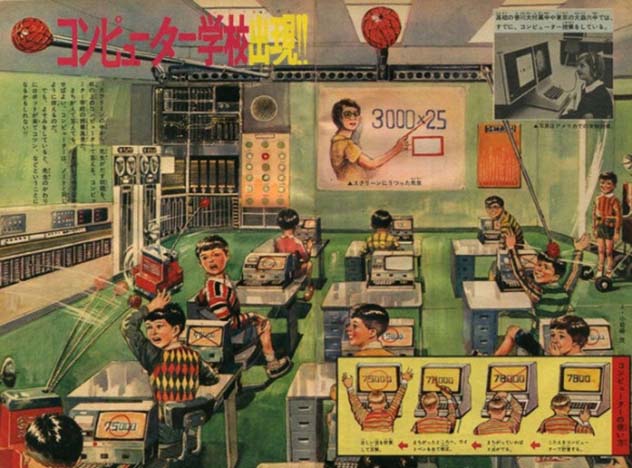
A series of pictures recently surfaced on a Japanese forum. Taken from a Showa-era newspaper, they were an attempt to predict what Japan would look like in 2011. Many of the scenes look like they’ve come straight out of 1950s science fiction comics.
In one of the images, a camera and some water jets create an automated fire extinguisher system, technology that is widespread today. In another, people stand around in spacesuits staring at screens that seem to show in-progress space exploration. In the distance is an elevated stadium which looks like a science fiction habitation biome, all things which are not common in the modern world. Beside it, however, aircraft are taking off vertically and the roofs of skyscrapers are covered in vegetation: these technologies have existed for years.
Perhaps the most disturbing scenes, though, are to be found in the picture of a 2011 classroom. In it, the teacher has been replaced by a slideshow showing a math question. The children have computers on their desks to input the correct answer: if they don’t, they are beaten by a robot, which is effectively a big club on wheels. In the corner, a child grins as it is restrained by some kind of time-out robot. Everything looks very clean though, so at least there’s that.[2]
8Everything Would Be Plastic
Here is an 8-minute video from 1957 which explores a house of the future. Fortunately for us, our modern homes look nothing like it. For starters, everything is plastic. Yes, everything. The floors, the walls, the ceilings, the countertops and the windows—all plastic, as are the cups and plates.
In the kitchen, the dishes are cleaned by a retractable dishwasher which uses ultra-sonic waves while doubling as storage space. The cooking range, meanwhile, isn’t gas. It isn’t even electric: it uses radiation waves, though it doesn’t look like there’s a protective screen. Tasty.
The narrator claims the bathroom contains objects of ‘pure fantasy’. These turn out to be an electric toothbrush and an electric razor, which we’d hardly bat an eyelid at today. The main entertainment in the living room is a built-in stereo system, something so phenomenally outdated that it’s almost laughable.
There is a scene, however, where one of the actors is speaking to her friend over the phone while getting ready to go out, without having to hold the telephone to her ear—so they were right about loudspeaker at least.[3]
7 We Would Have Pocket Computers
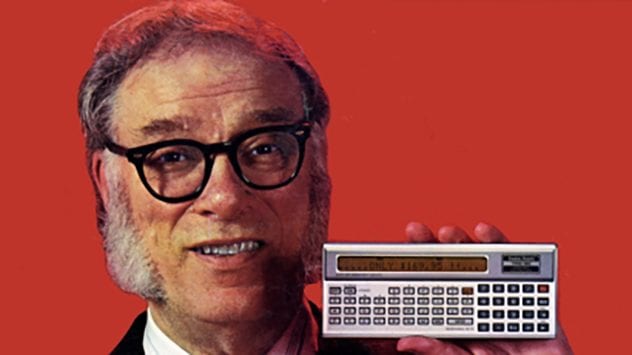
In 1977, a group of middle schoolers wrote to their local newspaper with their predictions of what life would be like in the year 2000. Most of their answers were surprisingly sensible, predicting the rise of things like electric cars and environmental issues while hoping for lower taxes and a better crime rate. They were clearly a product of their age: many expressed fears of a fuel shortage or another Great Depression.
A couple of their guesses, though, were much wilder. Marty Bohen said that by 2000 we’d all be living in round buildings. All workers would be robots and everyone would have a robot maid, and a button which would bring them anything they wanted. It all seems rather far-fetched until he casually slips in a prediction that we will have pocket computers containing everything we can name. With the rise of smartphones since 2007, he seems to have guessed that one perfectly.
John Vecchione thought that the year 2000 would look much better than 1977, predicting that the pollution problem would be solved and that cars would float on air. He himself would have a job designing ‘modern’ houses run entirely by solar power, with furniture that folded out from the walls and button-operated controls.[4]
6 There Would Be Flying Firemen and Robot Maids
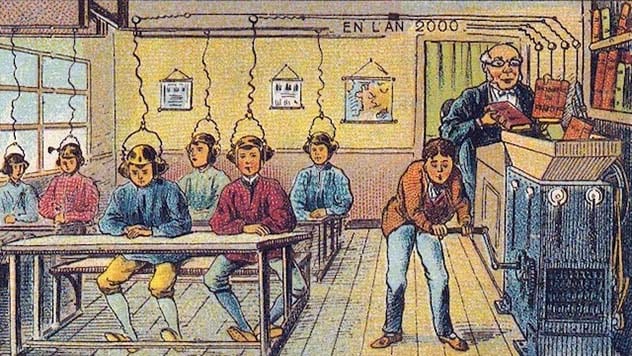
Between 1899 and 1910, a series of French artists produced a series of pictures showing what they thought life would be like in the year 2000, some of which were displayed at the World Exhibition in Paris. The idea was to predict what the 20th century would bring: none of them predicted the horrors of the first and second world wars or the rise of communism, but they did predict that automation would become a big issue—just not in the way they thought it would.
From the pictures, they clearly saw the robots of the future taking the place of the domestic staff they saw in the homes of the upper classes in their day. In one image a robot cuts customers’ hair in a barber shop, while in another a maid pilots a cleaning robot with a stick and a wire.
Every science fiction fan likes to dream of flying, though, and these artists were no exceptions. Another image shows an ‘aero-cabs’ port, where some well-dressed Victorian people are boarding a flying taxi—which looks like a yellow train with wings stuck on the sides. A flying car, complete with propeller, hurtles into view from the other side, just in case we didn’t get the message the first time.
In another picture, firemen with shoulder-mounted wings circle a burning building, removing people from the blaze. A steam train trundles by below, completely oblivious to the century of change that is supposed to have happened around it.[5]
5Fashion Would Be Scientifically Practical
A short clip made in 1939 tried to predict what clothing would look like in the year 2000. Unsurprisingly, it is often wildly inaccurate—but in some ways it predicted the future bang on.
It says the skirt will disappear entirely, with women going on to wear trousers. While dresses are still popular, the vast majority of women today tend to wear jeans as their main choice of casual wear. In the clip, though, this new outfit for women is also accompanied by an electric belt, which would supposedly adapt the body to climatic changes. No, we have no idea, either. Elsewhere, it predicts that women will wear dresses made out of net—and while their version, with weird coils of metal over the breast, never became fashionable, shirts made out of fabric mesh are a fashionable part of the modern wardrobe. Aluminum dresses and flashlights as hair accessories never caught on (un)fortunately.
Men’s fashion in the year 2000 is concluded in just over ten seconds. Men’s clothes won’t have any collars, ties or pockets: he will instead wear a strange set of overalls. He will carry a radio, telephone, and a set of small containers at all times, along with “candy for cuties”, something that might get you arrested today.[6]
4Barcoded Money and Futura-Rock

In 1988, the Los Angeles Times magazine published a special issue predicting what life would be like in 25 years’ time. Their visions of the distant year of 2013 are surprisingly accurate in some areas: they even correctly predicted the internet when they said the world’s computers and electronic devices would all be connected to the Integrated Services Digital Network.
In other ways, though, they missed the mark completely. For instance, the article also predicts that bills would have barcodes on them, to avoid corruption and crime. The city of LA would have to make businesses stagger their working times to cut down traffic (though they were right when they said traffic in LA would still be a problem). And, no, most of us haven’t replaced our pets with robotic versions and robot butlers still aren’t a thing, even though they’ve been predicted by science fiction fans for decades.
In their view of 2013 LA, multiple families would have to cram into single homes because of a housing shortage. Drivers are taxed for using their cars in the city, and none of us have to brush our teeth because we’ll all use ‘denturinse’. Oh, and all the kids will listen to a new genre of music known as ‘futura-rock’. Of course, none of these things actually happened, though they were very plausible at the time.[7]
3 Back To The Future 2 Was Plausible
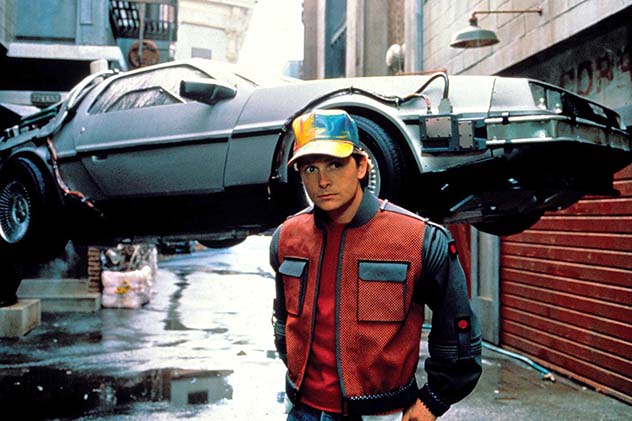
This one is a little different: in 2014, Business Insider asked people over the age of 40 what they used to think the future would look like when they were young. The conclusion? Most people thought the 2000s would look a lot more like ‘Back to The Future 2’ than it actually does.
One respondent wrote that, when the film first came out, it seemed like a fairly reasonable—if slightly optimistic—view of what like in the 2000s would be like. They genuinely thought that by now we’d have discovered a way to feed ourselves with just nutritional pills, and that flying cars and fusion power would be a common sight. Another user said they thought the hoverboards in the film would certainly exist as a toy by now, and that they had expected jetpacks to exist as a form of transportation.
It seems rather funny to us, but when you consider that the film was released a quarter of a century ago, it’s reasonable for someone then to assume that we’d have a manned base on the moon by now, or that we’d all be riding in self-driving cars. After all, wouldn’t we in the present expect those things to exist 25 years from now?[8]
2 Cities Suspended By Balloons
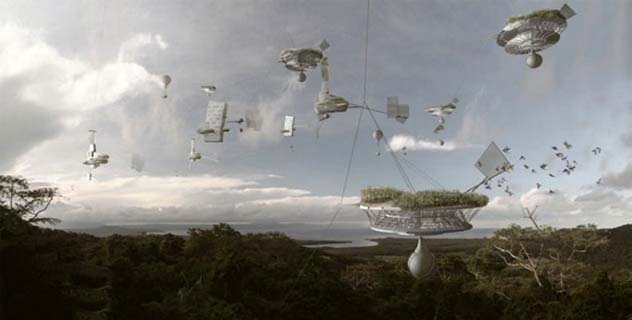
A report by the UK’s Office for Science, prepared for the British government, has recently revealed what people in the past thought the cities of now could look like. Titled ‘A Visual History of the Future’, it reveals some of the innovative plans put forward in the past for dealing with the problems of the modern city. Some are crazier than others.
Coastal problems are a legitimate issue in the modern world, but so far we haven’t found an ambitious solution. For the most part, our answer is to use hard engineering techniques like flood walls to protect our cities from coastal damage.
In the past much more ambitious ideas were put forward, such as this plan for a so-called sky city. In this plan, chosen communities would be hoisted into the air with huge helium balloons to protect them from damage. These contraptions would make use of cloud skippers, which would float on the jet stream, allowing them to be maintained in the air with minimal resources. The idea was a competition entry, designed as a housing solution to be used in the aftermath of a coastal disaster.[9]
1 Multi-Level Traffic
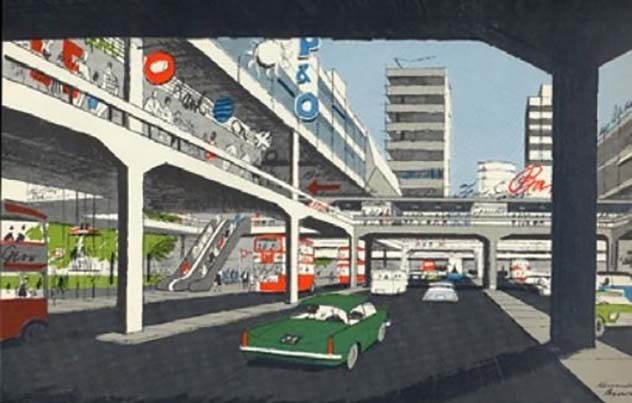
Another unusual solution from the same report was drawn up by Colin Buchanan in 1963. At the time, car ownership was growing in the UK, and was only expected to grow quicker. The Ministry of Transport was worried about the effect this would have on roads, so they began thinking of potential solutions.
They came up with a plan that would fundamentally alter the look of cities in the UK. Alongside more conventional solutions, such as using speed bumps to encourage slower driving, they came up with a plan to separate pedestrian and vehicle traffic by building raised walkways for pedestrians. Multi-level traffic would allow the city to handle a much higher volume of traffic without having to tackle high levels of congestion or using too much space. The sheer cost of building these new concrete tiers probably meant the plan was never truly possible, but it’s an interesting vision of what the UK’s cities could have looked like. It would almost certainly have improved things, too—unless you were a cyclist.
For more lists like this, check out 10 Crazy Futuristic Predictions, and 10 Ridiculously Specific Predictions That Came True.








